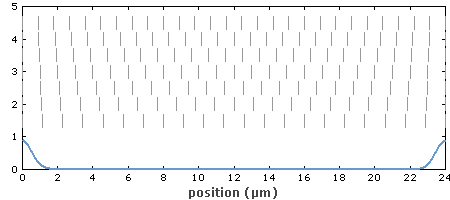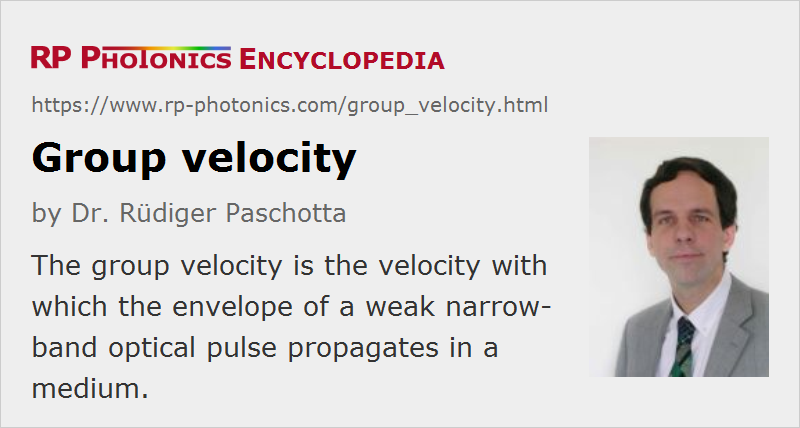Group Velocity
Definition: the velocity with which the envelope of a weak narrow-band optical pulse propagates in a medium
More general term: velocity of light
German: Gruppengeschwindigkeit
Categories: general optics, light pulses
Formula symbol: vg
Units: m/s
How to cite the article; suggest additional literature
Author: Dr. Rüdiger Paschotta
The group velocity of light in a medium is defined as the inverse of the derivative of the wavenumber with respect to angular frequency:

where n(ω) is the refractive index and ng is called the group index. The wavenumber k can be considered as the change in spectral phase per unit length.
The group velocity is the velocity with which the envelope of a pulse propagates in a medium, assuming a long pulse with narrow bandwidth (so that higher-order chromatic dispersion is not relevant) and the absence of nonlinear effects (i.e., low enough optical intensities).
Figure 1 illustrates how the different frequency components combine to form a pulse, and how the different velocities arise. The gray lines indicate the wavefronts for some of the frequency components of the pulse (spatially offset for clarity). Due to chromatic dispersion, the higher-frequency components have somewhat lower phase velocities. The pulse maximum forms where the wavefronts coincide (constructive interference), and it propagates with the group velocity (which in this example is 80% of the medium phase velocity).

In the shown example, there is a reduced group velocity, but no temporal pulse broadening, since the group velocity is constant over the whole pulse spectrum, i.e., there is no group velocity dispersion.
Due to chromatic dispersion, the group velocity in a medium is in general different from the phase velocity (typically smaller than the latter), and it is frequency-dependent; this effect is called group velocity dispersion. The difference between group velocity and phase velocity also changes the carrier–envelope offset of the pulse.
In analogy with the refractive index, the group index (see the equation above) can be defined as the ratio of the group velocity in vacuum to the group velocity in the medium.
Under certain circumstances, the group velocity can be higher than the vacuum velocity of light. However, this does not allow for superluminal transmission of information, which would amount to a violation of causality. There are also cases with a strongly reduced group velocity dispersion (usually in the vicinity of some narrow resonance) (slow light, a hot topic of current research).
Group Velocity in a Waveguide
For light propagating in a waveguide such as an optical fiber, the group velocity can be calculated by replacing the wavenumber k with β (the imaginary part of the propagation constant) (or replacing the refractive index n with the effective refractive index) in the equation given above. The deviation of that result from the group velocity in a homogeneous medium can be interpreted as the influence of waveguide dispersion.
Group Velocity in Nonlinear Propagation
In the literature, a certain group velocity is sometimes assigned even to a broadband pulse with complicated shape, or to a soliton pulse where an optical nonlinearity has an important influence (see e.g. Ref. [1]). However, this use of the term group delay is questionable, because it effectively redefines the term, giving it a different meaning, and can thus be misleading. Note that some frequently used relations involving the group velocity (as discussed above) are not valid in the nonlinear regime.
Questions and Comments from Users
Here you can submit questions and comments. As far as they get accepted by the author, they will appear above this paragraph together with the author’s answer. The author will decide on acceptance based on certain criteria. Essentially, the issue must be of sufficiently broad interest.
Please do not enter personal data here; we would otherwise delete it soon. (See also our privacy declaration.) If you wish to receive personal feedback or consultancy from the author, please contact him e.g. via e-mail.
By submitting the information, you give your consent to the potential publication of your inputs on our website according to our rules. (If you later retract your consent, we will delete those inputs.) As your inputs are first reviewed by the author, they may be published with some delay.
Bibliography
| [1] | H. A. Haus and E. P. Ippen, “Group velocity of solitons”, Opt. Lett. 26 (21), 1654 (2001), doi:10.1364/OL.26.001654 |
See also: group velocity dispersion, phase velocity, group delay, group velocity mismatch, carrier–envelope offset, velocity of light
and other articles in the categories general optics, light pulses
 |



If you like this page, please share the link with your friends and colleagues, e.g. via social media:
These sharing buttons are implemented in a privacy-friendly way!